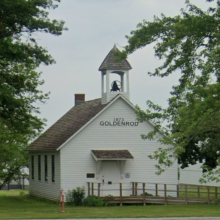The Goldenrod School (Fremont No. 8) opened in 1873 in section 34 of Fremont Township and operated through the 1959-1960 school year. It was 23 ft. x 33 ft. While it was open, it was called both the Goldenrod School and the Quist School. In 1965 the building was moved to the Page County Fairgrounds in Clarinda to be used as a museum, but it was moved once more in 1993 to its current location at the Nodaway Valley Historical Museum, also in Clarinda. The school was added to the National Park Service's National Register of Historical Places in 1975.
The Goldenrod School is well-known for being the birthplace of the 4H program. In 1901, teacher Jessie Fields Shambaugh started two after school clubs for her students - the Girls Home Club and the Boys Corn Club - as a way to learn additional skills key to the rural lifestyle. In 1906, she became the county's superintendent. In this role she was able to spread this after school curriculum to each of the county's 130 rural schools. Additional clubs were added to fit student's interests and schools would hold competitions for the student's to show what they learned - much like the 4H exhibitions at county fairs today. Around 1910, the clubs adopted the 3-leaf clover as their symbol with a corn kernel in the center; each leaf was named with either "Head", "Heart", or "Hands." The fourth "H" and clover leaf was added circa 1912, and by 1914, the new 4H program became a national organization. Jessie Fields is regarded as the "Mother of 4H."
For a 3D tour of the building or more information, visit the Nodaway Valley Historical Museum's website.
Photo credit: Google Maps, dated 2023
| Official School Name | Fremont No. 8 |
|---|---|
| Parochial School Name | Goldenrod School, Quist School |
| When Built | 1873 |
| When Closed | 1959 |
| Current Use | Museum |
| Materials Used For Construction |

